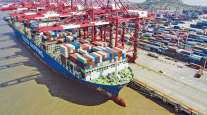US Ocean Imports Set to Grow Amid Glut in Container Capacity

This story appears in the April 10 print edition of Transport Topics.
While Asian-U.S. imports and exports are due to rise in 2017, an overcapacity of containerships will continue to create problems for the ocean freight industry this year.
That was the view of economists and industry consultants participating in Southern California’s annual “Pulse of the Ports: Peak Season Forecast” at the Port of Long Beach late last month.
IHS Maritime & Trade senior economist Mario Moreno projected containerized imports from Asia will rise 6.9% this year and that loaded container traffic should reach 16 million industry-standard 20-foot-equivalent units, or TEUs. He also predicted the gross domestic product will grow 2.3%. In 2016, imports from China increased 4% and GDP rose 1.6%.
“Import prices should remain subdued, helped by a strong U.S. dollar,” Moreno said, once again led by China.
At the Truckload Carrier Association’s conference in March, Forbes publisher and columnist Rich Karlgaard told trucking executives that GDP needs to grow at a 3% annualized rate or higher — an estimate used by trucking executives during interviews with Transport Topics.
Despite the positive outlook, industry analysts believe the growth will make only a small dent in the chronic overcapacity issues in the ocean container industry. Since 2010, revenue has dropped 21% to $151.2 billion, and earnings before interest, taxes, depreciation and amortization have plummeted 68% to $9.9 billion among the major steamship lines, according to data from research and analysis company CapIQ and earnings reports.
But during the same period, debt increased 18% to $100.3 billion and global fleet capacity grew 45%.
Alphaliner researchers forecast fleet capacity will rise 15% by the end of 2019, including more megaships that can carry 18,000 TEUs, such as the 1,300-foot CMA CGM Benjamin Franklin. But as copper and steel prices have risen in recent months, it also has provided more financial incentive to steamship lines to scrap older vessels and pare the fleet.
Last year, CapIQ data showed steamship lines reported a $1.3 billion combined operating loss.
“The word we hear on the street as far as rate levels and supply and demand levels does not bode well for the carrier picture going forward as well,” AlixPartners Vice President Jim Blaeser said in a Stifel, Nicolaus & Co. conference call. “Carriers for years and years have ordered more vessels to build up in an arms race, believing that demand would grow 5% per year. And while those vessels have come online, the demand has failed to keep pace. The carriers have also not been disciplined about pricing or rationalizing the fleet.”
Spot rates dipped in 2016 to less than $1,000 per 40-foot-equivalent unit, or FEU, in certain trans-Pacific lanes, until the Hanjin Shipping Co. bankruptcy at the end of August. Rates have increased afterward to around $1,500 per FEU, according to data from the Shanghai Container Freight Index. Along with the stronger dollar, the result is that U.S. exports become less attractive.
“The demands that Mario [Moreno] presented were very favorable, and the industry will certainly welcome those. I would hope Mario would agree that it’ll take a number of years of that kind of growth performance [in his forecast] to balance this market without a significant supply reduction in vessels,” Blaeser said.
Moreno also warned that President Donald Trump could hurt the economy if he imposed punitive tariffs on China or began a trade war, although he said the likelihood of such a scenario was low. Data from the port authorities show that about 68% of the Chinese exports to the United States were unloaded on the West Coast in 2015.
“In terms of TEU volumes, it seems like the cost [of a trade war] would be the same for both countries. According to IHS world trade service data, about 24% of Chinese TEU exports were shipped to the U.S. in 2015, while similarly 24% of U.S. TEU exports were shipped to China last year … so both sides would lose,” he said.
On March 31, Trump signed two executive orders to review of the causes of the trade deficit and order stricter enforcement of the existing international trade laws. He said that his administration would take all lawful steps to eliminate trade abuse.
In 2016, there was a 1.18 percentage-point spike in the third quarter in GDP growth in exports that economists credited to growing Chinese demand for U.S. fruit, nuts and meats. Increased Chinese demand for U.S. food and beverages would benefit trucking companies hauling food exports to ports in Oakland, Calif., Seattle and Houston.




